I beg to differ!
While I would agree that there exists an abundance of poorly written garbage for children out there, and many "just for fun" books (the kids' equivalent of, let's say, pop novels for adults), a great many richly illustrated and cleverly wordsmithed picturebooks have been published in recent years. And although these books are typically sold in the children's section of bookstores, the themes they address are often considerably beyond what most children discuss or think about eloquently without the support of an adult.
Consider, for example, Eve Bunting's "Wednesday Surprise", encompassing illiteracy and intergenerational relationships, and highlighting the daily realities of a blue-collar family. Well known for their nuanced treatment of social themes like homelessness, poverty and immigration, Bunting's books are also literary works in their own right, introducing school-aged readers to a number of literary devices which they will hopefully encounter in novels and other texts they attack later on in their school careers and personal lives. Although Bunting's work consists mainly of "just picturebooks", students benefit from multiple readings and re-readings of her texts in order to really dig into the meat of what she offers.
I have often marvelled at the language in the work of Eve Bunting and other children's authors, as it offers a far more developed linguistic pallette than some of the more voraciously read adult works currently on the market. ("50 Shades of Crappy Writing", anyone?!)
In our Grade 3 classes this year, my colleague and I are using a number of picture books each month to address school-wide themes like "Peace", "Building Supportive Communities" and others suggested by ETFO's "Social Justice Begins with Me" resource and adopted by our school. Many of the texts we are using to introduce and foster an understanding of these themes come from the SJBWM kit, but others have been added to our list. (See word doc. below for a complete, by-month list).
We use the books as tools for teaching, modeling and practising literacy strategies from our CAFE menu board, and as springboards for "Grand Conversations", in which the students engage in small groups after the second or third reading and class dissemination of any given picture book on the list. (Two Smart Notebook 11 files are posted below, which include examples of guiding questions for such conversations.)
|
| ||||||
The White Socks story was a good one, and raised the intended issue for tomorrow's discussion that I had hoped it would, namely peaceful protest. However, the scene at the end of the story drew our attention to another concern, that is, stereotyping (the final page, where the Bully Man is implied to have turned into a large, white chicken -- while providing poetic justice -- does little to counteract the stereotype that all black people are into voodoo, for example).
Between the intended and emergent fodder for social justice conversations and the material for illustrating and teaching descriptive writing, this book -- as many of the others on our list -- are chock full of good teaching stuff!!! Had we more time, I could milk this picturebook for at least another week!
So, if you are not a teacher, and you consider picturebooks for children only, I invite you to reconsider your stance. Ask a teacher you know for her three favourite titles, and get her to tell you why. You might be surprised at what you discover!


 RSS Feed
RSS Feed